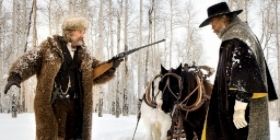 It’s hard to imagine a quiet Quentin Tarantino movie. The seminal writer/director is known for his talky, loud and ultra-violent masterworks of unique cinematic vision and, with each one, his legend and following grow larger. His last film, 2012’s Django Unchained, was a no-holds-barred, explosive, over-the-top and somewhat cathartic examination of the roots of racism in the United States—a broad subject, to be sure. A Tarantino movie can always be counted on to be many things: violent, dialogue and character-driven and somewhat political. What a Tarantino movie usually is not is small, slow and ultra-calculated. Which makes his new film The Hateful Eight different in so many ways. Not always better, but oh so delightfully different.
It’s hard to imagine a quiet Quentin Tarantino movie. The seminal writer/director is known for his talky, loud and ultra-violent masterworks of unique cinematic vision and, with each one, his legend and following grow larger. His last film, 2012’s Django Unchained, was a no-holds-barred, explosive, over-the-top and somewhat cathartic examination of the roots of racism in the United States—a broad subject, to be sure. A Tarantino movie can always be counted on to be many things: violent, dialogue and character-driven and somewhat political. What a Tarantino movie usually is not is small, slow and ultra-calculated. Which makes his new film The Hateful Eight different in so many ways. Not always better, but oh so delightfully different.
The Hateful Eight is Quentin Tarantino at his classic filmmaking-student best. This film is an homage to so many great elements of moviedom’s past, from the incredibly lush score by Ennio Morricone, to the western genre (and all of its tropes), to the Agatha Christie-style plot, to the clearly obvious: Tarantino shooting the film in 70mm Ultra Panavision, the first film to be shot in this format since 1966. The fact this film is such a throwback is not lost anywhere in this movie, as so much feels authentically retro, from the full 6-horse stagecoach to the classic Western movie setup. And then we move to the Hitchcock and Agatha Christie influences—a mystery whodunit of characters trapped in an enclosed space. With even a little Stephen King thrown in? The winter snowstorm—which I’m convinced is the reason he wanted to shoot this in 70mm—is a character unto itself here, and, for me, the best part of the movie.
Let me back up a bit. The Hateful Eight is set a few years after the conclusion of the Civil War in Wyoming in the dead of winter. It’s about a bounty hunter John Ruth (Kurt Russell) who is trying to get his fugitive prize Daisy Domergue (Jennifer Jason Leigh) into town so he can claim the reward, but a monster storm sits between him and his payday, so he is forced to wait it out in a cabin in the middle of nowhere (it is Wyoming, after all). Ruth soon finds out he’s not alone in having to detour, however, as it turns out several others have holed up in the same cabin to wait out the same storm. As the story progresses, it is revealed that not all is as it seems and not all are who they say they are and the end result is a unique blend of chamber piece, play, mystery and Tarantino bluster. And, of course, violence.
So when I said this movie was small, perhaps I meant by Tarantino standards only, because it is large in scope of themes (racism, justice) and, of course, said trademark violence. But it is small in the fact that it plays more like a play than a standard movie—or like any other Tarantino movie. Featuring just 8 main characters and set in only two locations (the stagecoach and the cabin), The Hateful Eight easily can be broken up into two acts and feels like a play—more specifically, a mystery. This is the best part of the movie and what keeps you engaged. Unfortunately, once you get past the whole whodunit part of the film, there really isn’t a whole lot to care about as the screenplay runs a little thin. Even more unfortunate, Tarantino is far from finished once the mystery of the screenplay has run its course, as the film mutates into a bloated diatribe on racism that not only is ineffectual but serves to undermine any of the entertainment/enjoyment that had preceded it.
But what has always been completely effectual in any Tarantino movie has been the casting—and The Hateful Eight is no different. The entire cast, even Kurt Russell, who I’ve never liked, does a great job at chewing just the right amount of scenery, as is required in a Tarantino movie, without coming off as ridiculous or out of place. Every actor is a joy to watch, particularly Walton Goggins, who is perhaps the least famous of the bunch, but who rises to the challenge and steals the movie even away from Samuel L. Jackson and is fantastic. My only beef is with Jennifer Jason Leigh, whose cartoonish performance I could’ve done without, but, then again, I probably could have done without a lot of things in this movie.
Nevertheless, the overall experience of The Hateful Eight, for me, was about the first two-thirds of the movie, which were a devilishly good time. In 70mm, it looked incredible, the Morricone soundtrack was awesome, the classic whodunit setup lured me in and I was hooked by all the elements—character, setting and story. It’s just too bad the payoff in the last third of the movie had to divulge into a Tarantino wasteland of violence and degradation that made it all feel pointless.
But, who knows. Maybe that is the point. With Tarantino, anything is possible.
